Jigsaw puzzle accessories
Jigsaw puzzle accessories are the different accessories used by jigsaw puzzle enthusiasts in pursuit of their hobby.
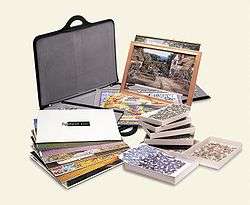
History
Jigsaw puzzles were made commercially available in England by John Spilsbury, around 1760[1] and have been widely accepted home entertainment in the UK ever since. Jigsaws enjoy similar popularity throughout Europe, and in the American Great Depression jigsaw puzzles sold at the rate of 10 million per week.[2] It is perhaps therefore surprising that companies who produce games and puzzles have been slow to exploit the commercial opportunities afforded by so many enthusiasts who require something on which to construct their jigsaws along with methods of storing and displaying them.
The first references to any kind of jigsaw puzzle accessory can be found around 1900 when a "Frame" was first included in Dutch jigsaw puzzle boxes[3] so that a completed puzzle could be permanently saved. The idea was not successful and was soon discontinued. A similar fate befell the mahogany and walnut "Puzzle Trays" that were advertised in Viking's Picture Puzzle Weekly in America during the 1930s[4]
Without the protection afforded by intellectual property rights, most companies are reluctant to make large investments in product development and promotion and one of the main obstacles to the commercialisation of jigsaw puzzle accessories has been the difficulty in obtaining such protection. The most prevalent function of a jigsaw accessory is to provide a surface on which to construct the puzzle and then quickly pack it away in its part-assembled state; products most often take the form of mats that can be rolled up (complete with puzzle pieces) or boards that can be stored in a case. Such functionality is so basic that it has been found to be almost impossible to secure patents and this probably explains why no accessories became readily available until nearly the end of the 20th Century.
In the late 1980s Falcon Games in England decided to tackle the intellectual property issue by route of applying for a trademark and on 4 August 1989 their self-explanatory Jigroll name was registered (UK Patent Office Reference 1318441). Although many companies have since copied the functionality of the Jigroll, none have been able to give their products the same name and in jigsaw puzzle parlance "Jigroll" has almost become a generic term for all jigsaw mats and rolls.
Falcon enjoyed similar success with the "Porta Puzzle" mark registered on 9 March 1993 (UK Patent Office Reference 1528876) for "Folders and cases made of plastics and/or card for holding and carrying jigsaw puzzles". Since the registration of this mark there have been a number of innovations and improvements to the original design, both by the current owners of the mark [5] and other companies, but collectively carrying cases for jigsaw puzzles are still most often referred to as "Porta Puzzles".
Jigsaw puzzle frames in which a completed puzzle can be displayed have never been very popular in either Europe or the US, but this is not the case in Japan where the customary use of jigsaws is for wall decoration. From the time that jigsaws first became available in Japan, in the 1970s,[6] jigsaw frames have been available to fit the jigsaw sizes of all the leading manufacturers.
Modern jigsaw puzzle accessories
Illustrated below are the most widely used modern products. Most of the accessories come in a range of sizes to cater for jigsaw puzzles between 500 and 2,000 pieces with the 1,000-piece size being the most popular.
Stand-alone construction tray
Construction trays are the most basic of all jigsaw puzzle accessories and they come in many different materials. Sizes required for different piece counts are as follows:
500 pieces: 520 mm x 395 mm (20.4" x 15.5")
1,000 pieces: Approximately 750 mm x 520 mm (29.5" x 20.4")
1,500 pieces: Approximately 915 mm x 660 mm (36.0" x 26.0")
The major problem with stand alone construction trays is that they cannot be packed away and stored with a part-assembled jigsaw. However, they can very easily be moved around from place to place in a home - the only functionality required by many people.
Roll-up mat
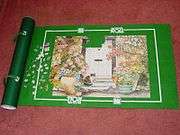
Launched in 1989, the Jigroll was the forerunner of modern jigsaw puzzle accessories. The jigsaw puzzle is constructed on a green cloth that has a coarse texture to which cardboard jigsaw pieces adhere. The non assembled pieces are also kept on the cloth. When the puzzle needs to be cleared away the entire cloth is rolled around a drum thus keeping both the assembled and non-assembled pieces trapped in position until the cloth is unrolled again.
Portfolio case
Portapuzzle obtained a registered trade mark for Falcon Games approximately 4 years after their successful launch of Jigroll (see above). A portfolio case opens out to reveal a foam-backed lining. The puzzle is constructed on one side of the case and the unassembled pieces are kept either on the other side of the case or on "Panels" provided. When closed up the foam-backed lining on either side of the case exerts enough pressure to keep the jigsaw pieces in place.
This invention is generally considered to be a safer way of keeping pieces in place but it involves more material and more assembly labour than a Jigroll and is consequently more expensive.
Portfolio case with separate construction tray

The outer carrying case holds a separate "Construction Tray" on which the jigsaw is made and "Sort Trays" on which the unassembled pieces are kept. The sort trays come complete with tightly fitting lids. To pack away the jigsaw the sort trays (with their lids in place) are fitted inside the construction tray and the whole is then zipped up inside the carrying case.
The separate construction tray is very light and can easily be moved around and an additional benefit is the raised edge around the outside of the tray that ensures pieces do not drop off and get lost. On the downside, the extra component parts add to the retail price.
Nesting boxes for unassembled pieces
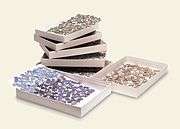
The loose pieces of a jigsaw take up approximately twice the space of a completed puzzle and these nesting boxes aim to solve the problem of how best to store 1,000 loose pieces in a small area. The boxes can be used for sorting different shapes or colours of piece. Each box has a removable insert so that sections of the puzzle can be constructed in the box and then easily moved to the developing jigsaw.
Jigsaw puzzle frames
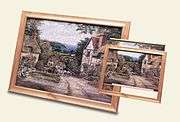
Traditionally (especially in Japan) jigsaw puzzles that are hung on a wall are glued onto a backing board. Once glued, it is a simple process to fit a puzzle into a frame in much the same way as a picture is fitted in a picture frame. However, gluing a puzzle to a board renders it unusable in the future as a puzzle. Products like the Jigframe resolve this issue with a shallow drawer incorporated into the frame that allows jigsaws to be framed without the use of glue.
Storage cases
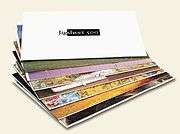
The product comes with 10 cardboard sheets on which completed puzzles are stored. The puzzles along with their cardboard sheets are stacked on top of each other in the manner of a multi-tiered sandwich. Ultimately the entire sandwich is held together with straps that are provided and then the whole is stored in an outer cardboard case.
This accessory is most suitable for dedicated enthusiasts, schools and clubs where there is a requirement to keep and display completed puzzles.
References
- ↑ History of Jigsaw Puzzles by Daniel McAdam
- ↑ Jigsaw Puzzles - A Brief History by Anne D. Williams
- ↑ Piece By Piece by Betsy and Geert Bekkering
- ↑ Leisure in the Great Depression by Anne D. Williams
- ↑ Hausemann & Hötte BV, Netherlands
- ↑ Imaginatorium Japanese Jigsaws